Multiscale Pore Structure Characteristics and Crack Propagation Behavior of Coal Samples from High Gas Seam
Abstract
:1. Introduction
2. Samples and Methods
2.1. Sample Preparation
2.2. Experimental Equipment and Schemes
3. Experimental Results
3.1. Mercury Injection Porosimetry
3.2. Low-Temperature Nitrogen and Carbon Dioxide Gas Adsorption
3.3. Three-Point Bending Experiments
4. Discussion and Analysis
4.1. Multiscale Pore Size Distributions
4.2. Surface Fractal Characteristics
4.3. Microcrack Propagation Process
4.4. Fracture Energy Analysis
5. Conclusions
- (1)
- The characteristics for coal samples with pore sizes ranging less than 370 μm was investigated using MIP, LT-NGA and LT-CA experiments. Meanwhile, the pore types of XZY coal samples are mainly opening pores. The coal matrix compression makes the measured pore volume larger, when mercury injection pressure greater than 20 MPa. The matrix compressibility coefficient is in the range of 1.278~1.309 × 10−10 m2/N. Removing the matrix compressibility effect, the mean corrected pore volume is 0.0352 mL/g.
- (2)
- The PSDs of XZY coal samples have multi-peak shapes. The adsorbed pore volume with an average of 0.0224 mL/g is the largest, followed by micro fractures. The volume content of seepage pores with sizes ranging from 100 nm to 10,000 nm accounts for 13.22% of the total volume. The surface fractal dimensions of adsorption pores, seepage pores, and micro fractures decrease in sequence, indicating that the pore structure is convenient for gas seepage, which explain the reason for high gas content in the 14-3# coal seam, but there was almost no gas outburst accident so far.
- (3)
- Based on the three-point bending experiment, the propagation path of the main crack is mainly affected by the natural crack and loading. With the increase in load, the main crack tends to expand almost perpendicular to the tensile direction until the specimen fails. Meanwhile, the fractal dimension of the main crack path increases, which changes from one to two. Both the energy accumulation and dissipation index α and bending failure time reveal the brittle failure characteristics of XZY coal samples.
Author Contributions
Funding
Institutional Review Board Statement
Informed Consent Statement
Data Availability Statement
Conflicts of Interest
List of Markings
| Eb | bending modulus, MPa |
| σt | tensile strength, MPa |
| KIC | fracture toughness, MPa·mm1/2 |
| k | slope of elastic stage |
| a | length of prefabricated notch, mm |
| h | height of the sample, mm |
| b | thickness of the sample, mm |
| l | effective support span, mm |
| kc | matrix compressibility coefficient, m2/N |
| Vc | volume of coal matrix, mL/g |
| P | mercury pressure, MPa |
| ΔVobs | observed mercury volume increment, mL/g |
| β | constant |
| dmin | minimal pore diameters, nm |
| dmax | maximal pore diameters, nm |
| Wn | accumulated surface energy |
| Qn | function of intrusion volume |
| mercury injected pressure at step i, MPa | |
| ΔVi | increment of mercury injected volume at pressure , mL/g |
| rn | smallest pore radius injected by mercury, nm |
| Ds | surface dimension |
| C | constant |
| εi | size of the box |
| N(εi) | number of images covered by the box |
| Gf | stands for fracture energy, N/mm |
| δe | displacement at the end of the loading, mm |
| α | energy accumulation dissipation index |
References
- Jiang, Y.; Pan, Y.; Jiang, F.; Dou, L.; Ju, Y. State of the Art on Mechanism and Prevention of Coal Bumps in China. J. China Coal Soc. 2014, 39, 2188–2204. [Google Scholar] [CrossRef]
- Saadat, M.; Taheri, A. Modelling Micro-Cracking Behaviour of Pre-Cracked Granite Using Grain-Based Distinct Element Model. Rock Mech. Rock Eng. 2019, 52, 4669–4692. [Google Scholar] [CrossRef]
- Ma, Y.; Nie, B.; He, X.; Li, X.; Meng, J.; Song, D. Mechanism Investigation on Coal and Gas Outburst: An Overview. Int. J. Miner. Metall. Mater. 2020, 27, 872–887. [Google Scholar] [CrossRef]
- Shadrin, A.V. Geophysical Criterion of Pre-Outburst Crack Propagation in Coal Beds. J. Min. Sci. 2016, 52, 670–682. [Google Scholar] [CrossRef]
- Hodott, B.B.; Song, S.; Wang, Y. Coal and Gas Outburst; China Building Industry Press: Beijing, China, 1966. [Google Scholar]
- Sing, K.S.W.; Everett, D.H.; Haul, R.A.W.; Moscou, L.; Pierotti, R.A.; Rouquérol, J.; Siemieniewaka, T. Reporting Physisorption Data for Gas/Solid Systems with Special Reference to the Determination of Surface Area and Porosity. Pure Appl. Chem. 1985, 57, 603–619. [Google Scholar] [CrossRef]
- Song, Y.; Jiang, B.; Li, M.; Hou, C.; Xu, S. A Review on Pore-Fractures in Tectonically Deformed Coals. Fuel 2020, 278, 118248. [Google Scholar] [CrossRef]
- Agioutantis, Z.; Kaklis, K.; Mavrigiannakis, S.; Verigakis, M.; Vallianatos, F.; Saltas, V. Potential of Acoustic Emissions from Three Point Bending Tests as Rock Failure Precursors. Int. J. Min. Sci. Technol. 2016, 26, 155–160. [Google Scholar] [CrossRef]
- Jiang, J.; Yang, W.; Cheng, Y.; Zhao, K.; Zheng, S. Pore Structure Characterization of Coal Particles via MIP, N2 and CO2 Adsorption: Effect of Coalification on Nanopores Evolution. Powder Technol. 2019, 354, 136–148. [Google Scholar] [CrossRef]
- Klaver, J.; Desbois, G.; Urai, J.L.; Littke, R. BIB-SEM Study of the Pore Space Morphology in Early Mature Posidonia Shale from the Hils Area, Germany. Int. J. Coal Geol. 2012, 103, 12–25. [Google Scholar] [CrossRef]
- Mahamud, M.M. Textural Characterization of Active Carbons Using Fractal Analysis. Fuel Processing Technol. 2006, 87, 907–917. [Google Scholar] [CrossRef]
- Sun, B.; Yang, Q.; Zhu, J.; Shao, T.; Yang, Y.; Hou, C.; Li, G. Pore Size Distributions and Pore Multifractal Characteristics of Medium and Low-Rank Coals. Sci. Rep. 2020, 10, 1–12. [Google Scholar] [CrossRef] [PubMed]
- Li, W.; Liu, H.; Song, X. Multifractal Analysis of Hg Pore Size Distributions of Tectonically Deformed Coals. Int. J. Coal Geol. 2015, 144–145, 138–152. [Google Scholar] [CrossRef]
- Suuberg, E.M.; Deevi, S.C.; Yun, Y. Elastic Behaviour of Coals Studied by Mercury Porosimetry. Fuel 1995, 74, 1522–1530. [Google Scholar] [CrossRef]
- Li, Y.; Lu, G.; Rudolph, V. Compressibility and Fractal Dimension of Fine Coal Particles in Relation to Pore Structure Characterization Using Mercury Porosimetry. Part. Part. Syst. Charact. 1999, 16, 25–31. [Google Scholar] [CrossRef]
- Hazra, B.; Vishal, V.; Singh, D.P. Applicability of Low-Pressure CO2and N2Adsorption in Determining Pore Attributes of Organic-Rich Shales and Coals. Energy Fuels 2021, 35, 456–464. [Google Scholar] [CrossRef]
- Reucroft, P.J.; Patel, K.B. Surface Area and Swellability of Coal. Fuel 1983, 62, 279–284. [Google Scholar] [CrossRef]
- Bonetto, R.D.; Ladaga, J.L.; Ponz, E. Measuring Surface Topography by Scanning Electron Microscopy. II. Analysis of Three Estimators of Surface Roughness in Second Dimension and Third Dimension. Microsc. Microanal. 2006, 12, 178–186. [Google Scholar] [CrossRef]
- Zhao, Y.; Zhao, G.; Jiang, Y. Experimental and Numerical Modelling Investigation on Fracturing in Coal under Impact Loads. Int. J. Fract. 2013, 183, 63–80. [Google Scholar] [CrossRef]
- Kwasniewski, M.A.; Wang, J.A. Surface Roughness Evolution and Mechanical Behavior of Rock Joints under Shear. Int. J. Rock Mech. Min. Sci. 1997, 34, 157.e1–157.e14. [Google Scholar]
- Koo, T.K.; Li, M.Y. A Guideline of Selecting and Reporting Intraclass Correlation Coefficients for Reliability Research. J. Chiropr. Med. 2016, 15, 155–163. [Google Scholar] [CrossRef] [Green Version]
- Neimark, A.V. Calculating Surface Fractal Dimension of Adsorbents. Adsorpt. Sci. Technol. 1990, 7, 210–219. [Google Scholar] [CrossRef]
- Zhang, B.; Liu, W.; Liu, X. Scale-Dependent Nature of the Surface Fractal Dimension for Bi- and Multi-Disperse Porous Solids by Mercury Porosimetry. Appl. Surf. Sci. 2006, 253, 1349–1355. [Google Scholar] [CrossRef]
- Zhang, B.; Li, S. Determination of the Surface Fractal Dimension for Porous Media by Capillary Condensation. Ind. Eng. Chem. Res. 1995, 34, 1383–1386. [Google Scholar] [CrossRef]
- Gagnepain, J.J.; Roques-Carmes, C. Fractal Approach to Two-Dimensional and Three-Dimensional Surface Roughness. Wenr 1986, 109, 119–126. [Google Scholar] [CrossRef]
- Singh, D.P.; Wood, D.A.; Hazra, B.; Singh, P.K. Pore Properties in Organic-Rich Shales Derived Using Multiple Fractal Determination Models Applied to Two Indian Permian Basins. Energy Fuels 2021, 35, 14618–14633. [Google Scholar] [CrossRef]
- Wood, D.A. Estimating Organic-Rich Shale Fractal Dimensions from Gas Adsorption Isotherms: Combining Different Methods Leads to More Reliable Values and Insight. Nat. Resour. Res. 2021, 30, 3551–3574. [Google Scholar] [CrossRef]
- Nasseri, M.H.B.; Mohanty, B.; Robin, P.Y.F. Characterization of Microstructures and Fracture Toughness in Five Granitic Rocks. Int. J. Rock Mech. Min. Sci. 2005, 42, 450–460. [Google Scholar] [CrossRef]
- Nasseri, M.H.B.; Mohanty, B. Fracture Toughness Anisotropy in Granitic Rocks. Int. J. Rock Mech. Min. Sci. 2008, 45, 167–193. [Google Scholar] [CrossRef]
- Fayyad, T.M.; Lees, J.M. Experimental Investigation of Crack Propagation and Crack Branching in Lightly Reinforced Concrete Beams Using Digital Image Correlation. Eng. Fract. Mech. 2017, 182, 487–505. [Google Scholar] [CrossRef] [Green Version]
- Peng, S.; Fang, Z.; Shen, J.; Xu, J.; Wang, G. Effects of Gas Sorption-Induced Swelling/Shrinkage on the Cleat Compressibility of Coal under Different Bedding Directions. Sci. Rep. 2017, 7, 14337. [Google Scholar] [CrossRef]
- Lim, I.L.; Johnston, I.W.; Choi, S.K.; Boland, J.N. Fracture Testing of a Soft Rock with Semi-Circular Specimens under Three-Point Bending. Part 1-Mode I. Int. J. Rock Mech. Min. Sci. Géoméch. Abstr. 1994, 31, 185–197. [Google Scholar] [CrossRef]
- Zhu, J.; Tang, D.; Shao, T.; Wang, Q.; Tang, J.; Sun, W. The Effect of Carbon Dioxide Treatment on Micro-Crack Propagation of Bituminous Coals. Geomech. Geophys. Geo-Energy Geo-Resour. 2020, 6, 1–17. [Google Scholar] [CrossRef]
- Md Rashadul, I.; Mohiuddin, A.; Rafiqul, A.T. Effect of Loading Rate on the Properties of Asphalt Concrete Using Three-Point Bending Test. Adv. Mater. Res. 2015, 1096, 553–556. [Google Scholar] [CrossRef]
- Zuo, J.; Li, Y.; Zhang, X.; Zhao, Z.; Wang, T. The Effects of Thermal Treatments on the Subcritical Crack Growth of Pingdingshan Sandstone at Elevated High Temperatures. Rock Mech. Rock Eng. 2018, 51, 3439–3454. [Google Scholar] [CrossRef]
- Vishal, V.; Rizwan, M.; Mahanta, B.; Pradhan, S.P.; Singh, T.N. Temperature Effect on the Mechanical Behavior of Shale: Implication for Shale Gas Production. Geosystems Geoenvironment 2022, 1, 100078. [Google Scholar] [CrossRef]
- Lei, B.; Zuo, J.; Liu, H.; Wang, J.; Xu, F.; Li, H. Experimental and Numerical Investigation on Shale Fracture Behavior with Different Bedding Properties. Eng. Fract. Mech. 2021, 247, 107639. [Google Scholar] [CrossRef]
- Dou, F.; Wang, J.G.; Zhang, X.; Wang, H. Effect of Joint Parameters on Fracturing Behavior of Shale in Notched Three-Point-Bending Test Based on Discrete Element Model. Eng. Fract. Mech. 2019, 205, 40–56. [Google Scholar] [CrossRef]
- Hao, X.; Yuan, L.; Wang, S.; Zhao, Y.; Xu, Q.; Li, Y.; Guo, Y. Study on Bedding Effect of Bump Tendency for Hard Coal. Coal Sci. Technol. 2018, 46, 1–7. [Google Scholar] [CrossRef]
- Ulusay, R. The ISRM Suggested Methods for Rock Characterization, Testing and Monitoring:2007–2014. Springer Int. Publ. 2014, 15, 47–48. [Google Scholar]
- Washburn, E.W. The Dynamics of Capillary Flow. Phys. Rev. 1921, 17, 273–283. [Google Scholar] [CrossRef]
- Li, Y.; Song, D.; Liu, S.; Ji, X.; Hao, H. Evaluation of Pore Properties in Coal through Compressibility Correction Based on Mercury Intrusion Porosimetry: A Practical Approach. Fuel 2021, 291, 120130. [Google Scholar] [CrossRef]
- Kaufmann, J.; Loser, R.; Leemann, A. Analysis of Cement-Bonded Materials by Multi-Cycle Mercury Intrusion and Nitrogen Sorption. J. Colloid Interface Sci. 2009, 336, 730–737. [Google Scholar] [CrossRef]
- Schmitt, M.; Fernandes, C.P.; da Cunha Neto, J.A.B.; Wolf, F.G.; dos Santos, V.S.S. Characterization of Pore Systems in Seal Rocks Using Nitrogen Gas Adsorption Combined with Mercury Injection Capillary Pressure Techniques. Mar. Pet. Geol. 2013, 39, 138–149. [Google Scholar] [CrossRef]
- Irwin, G.R. Analysis of Stresses and Strains near the End of a Crack Traversing a Plate. J. Appl. Mech. 1957, 24, 361–364. [Google Scholar] [CrossRef]
- China Academy of Aerospace. Stress Intensity Factor Manual; Science Press: Beijing, China, 1981. [Google Scholar]
- Brown, W.F.; Srawley, J.E. Plane Strain Crack Toughness Testing of High Strength Metallic Materials; American Society for Testing and Materials: Philadelphia, PA, USA, 1966. [Google Scholar]
- Zeng, Q.; Luo, M.; Pang, X.; Li, L.; Li, K. Surface Fractal Dimension: An Indicator to Characterize the Microstructure of Cement-Based Porous Materials. Appl. Surf. Sci. 2013, 282, 302–307. [Google Scholar] [CrossRef]
- Zhu, J.; Zhang, R.; Zhang, Y.; He, F. The Fractal Characteristics of Pore Size Distribution in Cement-Based Materials and Its Effect on Gas Permeability. Sci. Rep. 2019, 9, 1–12. [Google Scholar] [CrossRef]
- Sun, Y.; Zhao, Y.; Wang, X.; Peng, L.; Sun, Q. Synchrotron Radiation Facility-Based Quantitative Evaluation of Pore Structure Heterogeneity and Anisotropy in Coal. Pet. Explor. Dev. 2019, 46, 1128–1137. [Google Scholar] [CrossRef]
- Zhou, Z. The Least Energy Consumption Principle and Its Application; Science Press: Beijing, China, 2001; ISBN 7-03-008124-2. [Google Scholar]
- Kulatilake, P.H.S.W.; Balasingam, P.; Park, J.; Morgan, R. Natural Rock Joint Roughness Quantification through Fractal Techniques. Geotech. Geol. Eng. 2006, 24, 1181–1202. [Google Scholar] [CrossRef]
- Sun, B.; Liu, S.; Zeng, S.; Wang, S.; Wang, S. Dynamic Characteristics and Fractal Representations of Crack Propagation of Rock with Different Fissures under Multiple Impact Loadings. Sci. Rep. 2021, 11, 1–16. [Google Scholar] [CrossRef]
- Peitgen, H.-O.; Jürgens, H.; Saupe, D. Chaos and Fractals: New Frontiers of Science; Springer: New York, NY, USA, 1992; ISBN 978-0-387-21823-6. [Google Scholar]
- Schwarzenberger, R. Fractal Geometry: Mathematical Foundations and Applications. Math. Gaz. 1990, 74, 288–317. [Google Scholar] [CrossRef]
- Lin, Q.; Wang, S.; Wan, B.; Lu, Y.; Wang, Y. Characterization of Fracture Process in Sandstone: A Linear Correspondence between Acoustic Emission Energy Density and Opening Displacement Gradient. Rock Mech. Rock Eng. 2020, 53, 975–981. [Google Scholar] [CrossRef]
- Hu, X.Z.; Wittmann, F.H. Fracture Energy and Fracture Process Zone. Mater. Struct. 1992, 25, 319–326. [Google Scholar] [CrossRef]
- Rilem, T.C. Draft Recommendation: “Determination of the Fracture Energy of Motar and Concrete Bymeans of Three-Point Bend Tests on Notched Beams. ” Mater. Struct. 1985, 18, 484. [Google Scholar] [CrossRef] [Green Version]
- Su, C.; Yuan, R.; Zhai, X. Experimental Research on Bursting Liability Index of Coal Samples of Chengjiao Coal Mine. Yanshilixue Yu Gongcheng Xuebao/Chin. J. Rock Mech. Eng. 2013, 32, 3696–3704. [Google Scholar]
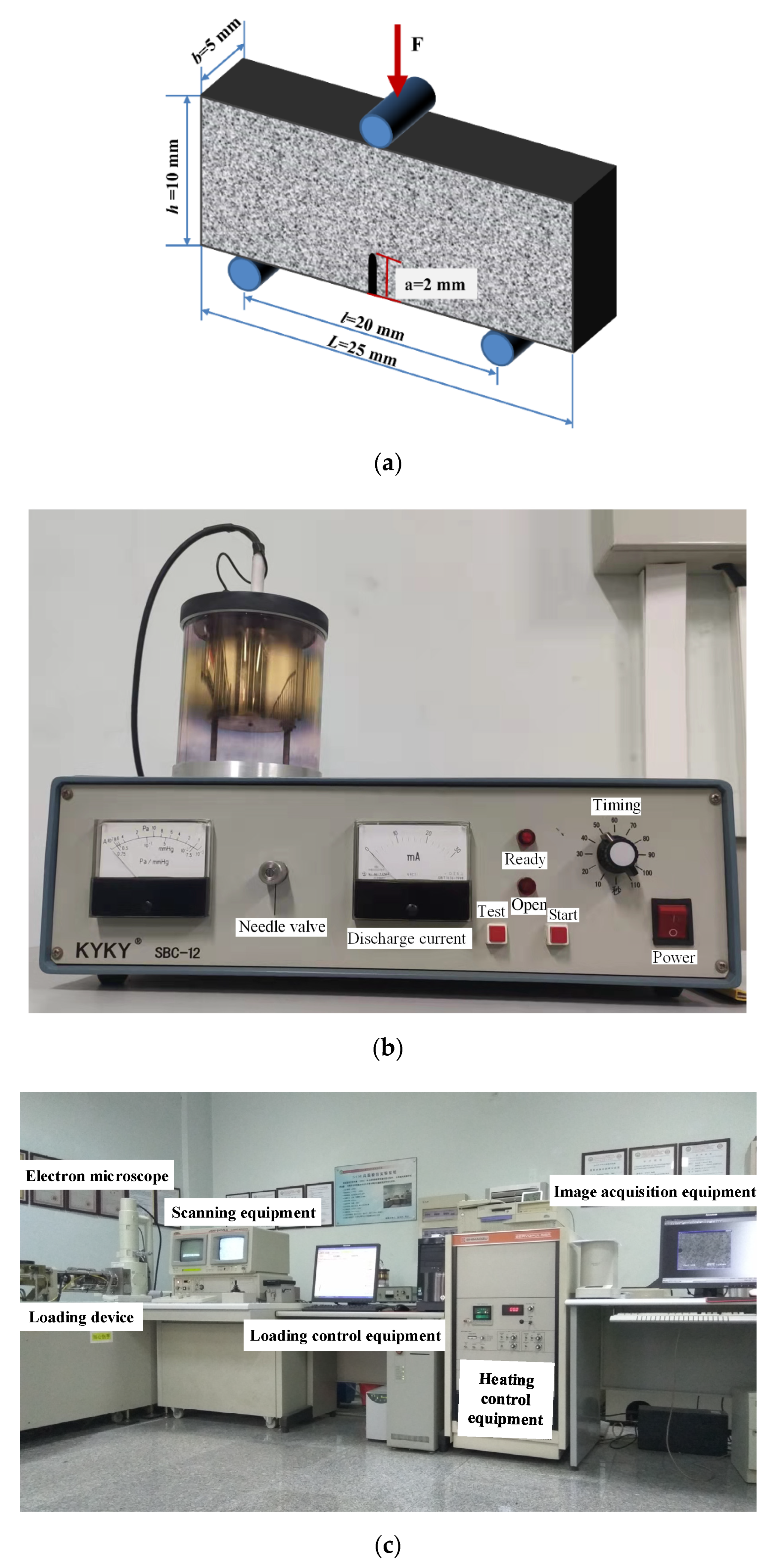

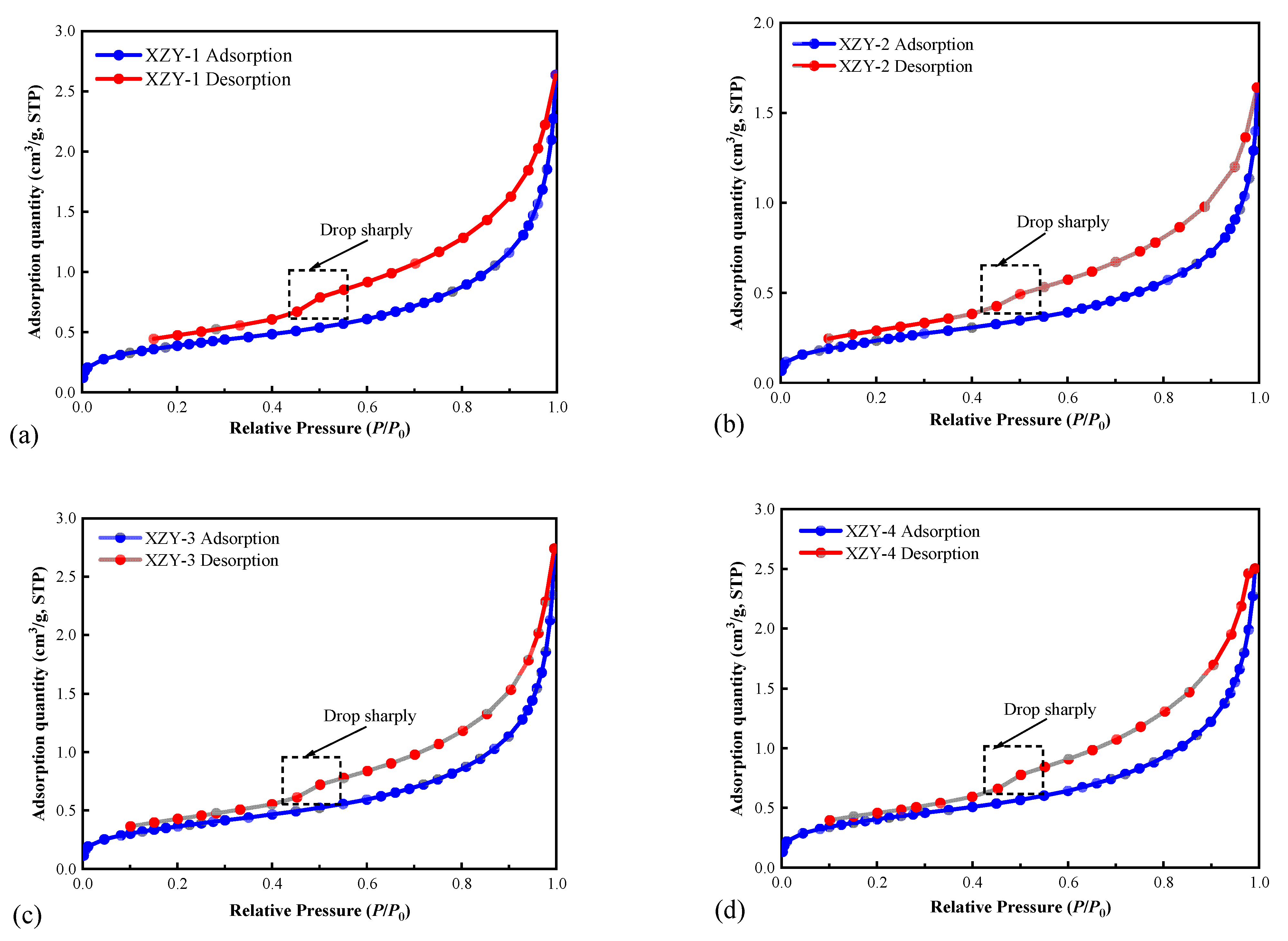
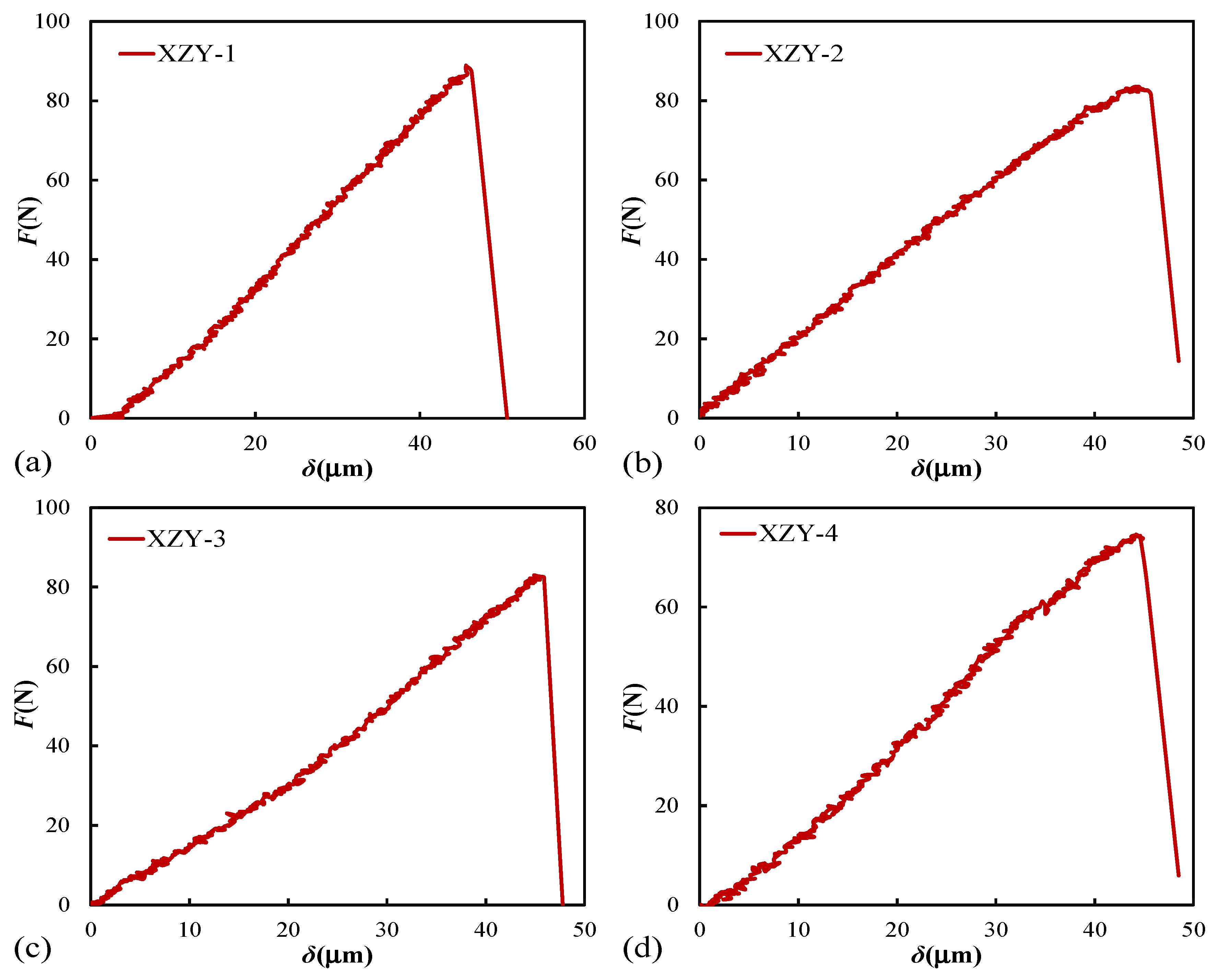
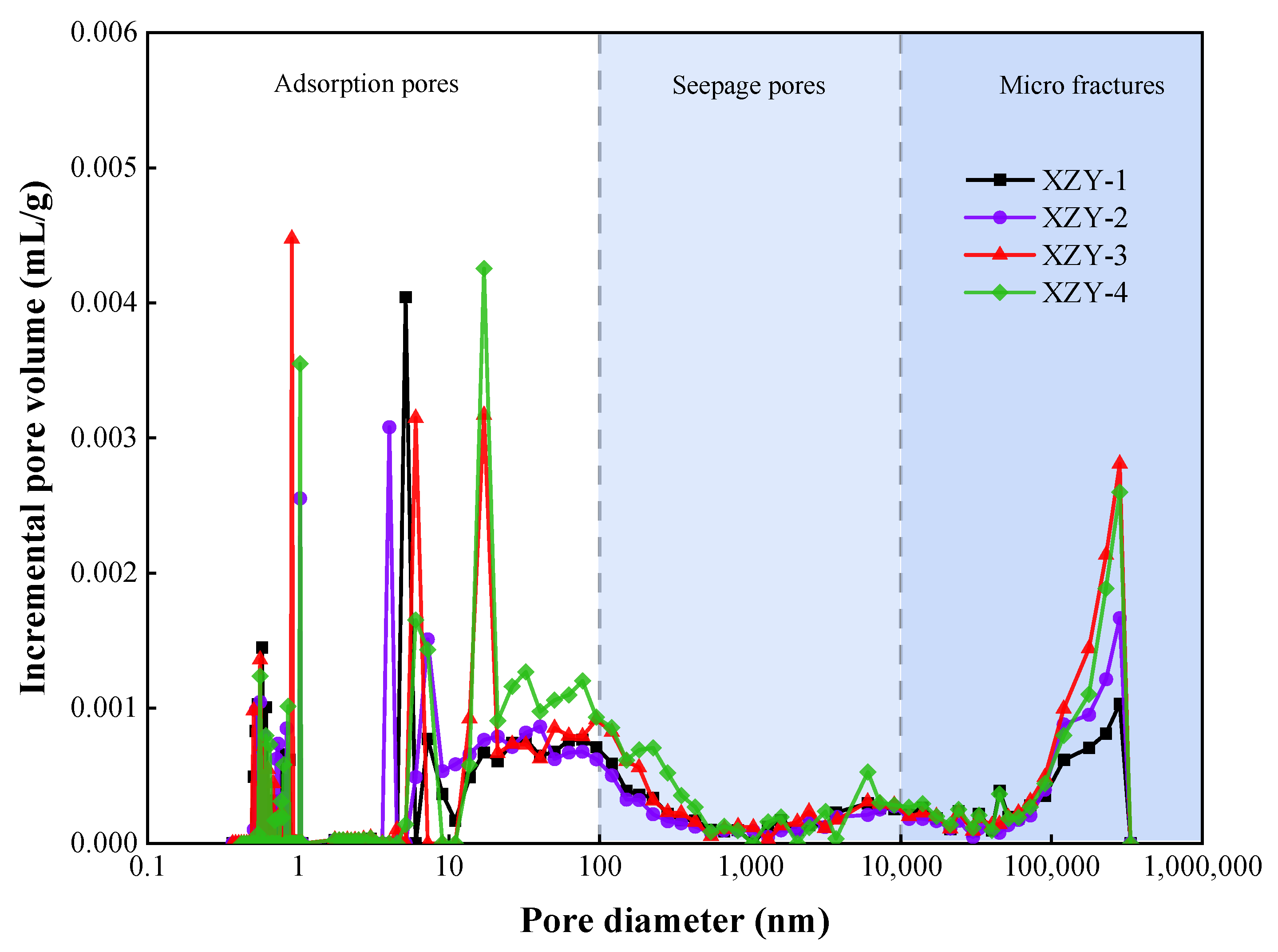



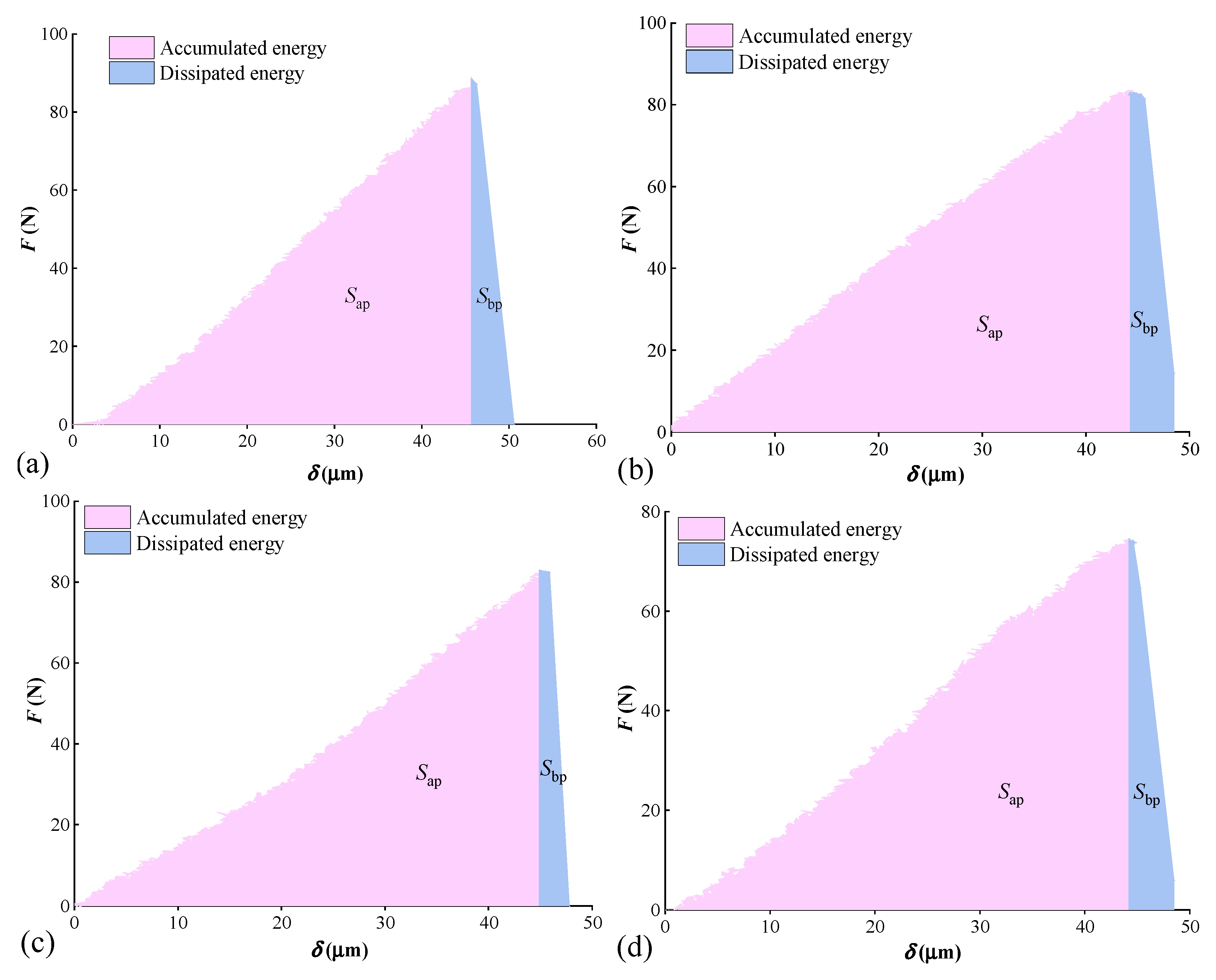
| Sample No. | Parameters Acquired from LT-CA Experiments | Parameters Acquired from LT-NGA Experiments | ||||||||
|---|---|---|---|---|---|---|---|---|---|---|
| Minimum Pore Diameter (nm) | Maximum Pore Diameter (nm) | Surface Area (cm2/g) | Total Pore Volume (cm3/g) | BET Average Pore Diameter (nm) | BET Surface Area (cm2/g) | Micro Pore Volume (cm3/g) | Transition Pore Volume (cm3/g) | Meso Pore Volume (cm3/g) | Total Pore Volume (cm3/g) | |
| XZY-1 | 0.3669 | 1.0657 | 23.49 | 0.0072 | 11.821 | 1.380 | 0.00086 | 0.00184 | 0.00069 | 0.0034 |
| XZY-2 | 0.3669 | 1.0657 | 22.28 | 0.0081 | 11.551 | 0.879 | 0.00063 | 0.00109 | 0.00043 | 0.0022 |
| XZY-3 | 0.3669 | 1.0657 | 24.68 | 0.0088 | 12.856 | 1.319 | 0.00087 | 0.00188 | 0.00080 | 0.0036 |
| XZY-4 | 0.4193 | 1.0657 | 22.54 | 0.0089 | 12.622 | 1.447 | 0.00091 | 0.00201 | 0.00084 | 0.0038 |
| Average | 0.3800 | 1.0657 | 23.25 | 0.0083 | 12.213 | 1.256 | 0.00082 | 0.00171 | 0.00069 | 0.0032 |
| Sample No. | Fmax (N) | δmax (μm) | k (N/μm) | Eb (MPa) | σt (MPa) | KIC (MPa·mm1/2) |
|---|---|---|---|---|---|---|
| XZY-1 | 88.9 | 50.6 | 1.81 | 1413 | 8.33 | 13.141 |
| XZY-2 | 83.5 | 48.5 | 2.01 | 1569 | 7.83 | 12.343 |
| XZY-3 | 83.0 | 47.8 | 1.51 | 1177 | 7.78 | 12.269 |
| XZY-4 | 74.6 | 48.5 | 1.62 | 1263 | 6.99 | 11.027 |
| Average | 82.5 | 48.9 | 1.74 | 1356 | 7.73 | 12.195 |
| Sample No. | β (10−5) | kc (10−10 m2/N) | Porosity Before Correction (%) | Porosity after Correction (%) | Accumulated Pore Volume before Correction (mL/g) | Accumulated Pore Volume after Correction (mL/g) | Volume Correction Rate (%) |
|---|---|---|---|---|---|---|---|
| XZY-1 | 10.8 | 1.278 | 6.32 | 3.85 | 0.0565 | 0.0299 | 47.08 |
| XZY-2 | 10.8 | 1.309 | 6.95 | 4.11 | 0.0625 | 0.0321 | 48.64 |
| XZY-3 | 10.4 | 1.293 | 7.45 | 4.83 | 0.0670 | 0.0376 | 43.88 |
| XZY-4 | 11.0 | 1.299 | 8.04 | 5.31 | 0.0717 | 0.0413 | 42.40 |
| Average | 10.8 | 1.295 | 7.19 | 4.52 | 0.0644 | 0.0352 | 45.32 |
| Sample No. | Ds1 | Ds2 | Ds3 | Va (mL/g) | Vs (mL/g) | Vf (mL/g) |
|---|---|---|---|---|---|---|
| XZY-1 | 2.967 | 2.870 | 2.577 | 0.0197 | 0.0042 | 0.0060 |
| XZY-2 | 2.998 | 2.866 | 2.454 | 0.0217 | 0.0036 | 0.0068 |
| XZY-3 | 2.919 | 2.915 | 2.422 | 0.0225 | 0.0050 | 0.0101 |
| XZY-4 | 2.848 | 2.979 | 2.469 | 0.0257 | 0.0062 | 0.0094 |
| Average | 2.933 | 2.908 | 2.481 | 0.0224 | 0.0048 | 0.0081 |
| Sample No. | The Stage before Peak Load | The Stage after Peak Load | ||||||||
|---|---|---|---|---|---|---|---|---|---|---|
| Load 1 (N) | Crack Initial Spreading Angle (°) | Fractal Dimension | Load 2 (N) | Fractal Dimension | Load 3 (N) | Crack Curve Length (mm) | Crack Linear Length (mm) | Maximum Crack Opening (mm) | Fractal Dimension | |
| XZY-1 | 63.8 | 79 | 1.285 | 73.4 | 1.292 | 43.6 | 9.47 | 7.30 | 0.118 | 1.362 |
| XZY-2 | 59.8 | 48 | 1.207 | 78.1 | 1.253 | 14.4 | 8.94 | 7.38 | 0.101 | 1.429 |
| XZY-3 | 53.6 | 84 | 1.215 | 68 | 1.237 | 71.3 | 8.77 | 7.28 | 0.112 | 1.433 |
| XZY-4 | 53.5 | 31 | 1.218 | / | / | 64.7 | 8.53 | 7.13 | 0.096 | 1.557 |
| Sample No. | Gf (N/mm) | Accumulated Energy (N∙mm) | Time before Peak Load (s) | Dissipated Energy (N∙mm) | Time after Peak Load (s) | α |
|---|---|---|---|---|---|---|
| XZY-1 | 0.052 | 1.816 | 592 | 0.249 | 5 | 0.14 |
| XZY-2 | 0.055 | 1.982 | 570 | 0.233 | 12 | 0.12 |
| XZY-3 | 0.046 | 1.684 | 600 | 0.161 | 5 | 0.10 |
| XZY-4 | 0.045 | 1.600 | 573 | 0.191 | 11 | 0.12 |
| Average | 0.049 | 1.77 | 583 | 0.21 | 8 | 0.12 |
Publisher’s Note: MDPI stays neutral with regard to jurisdictional claims in published maps and institutional affiliations. |
© 2022 by the authors. Licensee MDPI, Basel, Switzerland. This article is an open access article distributed under the terms and conditions of the Creative Commons Attribution (CC BY) license (https://creativecommons.org/licenses/by/4.0/).
Share and Cite
Zhu, J.; Shao, T.; Li, G.; Yang, Y.; Chen, Z.; Lan, T.; Wang, J.; Zhao, Y.; Liu, S. Multiscale Pore Structure Characteristics and Crack Propagation Behavior of Coal Samples from High Gas Seam. Materials 2022, 15, 4500. https://doi.org/10.3390/ma15134500
Zhu J, Shao T, Li G, Yang Y, Chen Z, Lan T, Wang J, Zhao Y, Liu S. Multiscale Pore Structure Characteristics and Crack Propagation Behavior of Coal Samples from High Gas Seam. Materials. 2022; 15(13):4500. https://doi.org/10.3390/ma15134500
Chicago/Turabian StyleZhu, Jie, Tangsha Shao, Guiyou Li, Yuhang Yang, Zhen Chen, Tianxiang Lan, Jinge Wang, Yuhan Zhao, and Shuangqing Liu. 2022. "Multiscale Pore Structure Characteristics and Crack Propagation Behavior of Coal Samples from High Gas Seam" Materials 15, no. 13: 4500. https://doi.org/10.3390/ma15134500
APA StyleZhu, J., Shao, T., Li, G., Yang, Y., Chen, Z., Lan, T., Wang, J., Zhao, Y., & Liu, S. (2022). Multiscale Pore Structure Characteristics and Crack Propagation Behavior of Coal Samples from High Gas Seam. Materials, 15(13), 4500. https://doi.org/10.3390/ma15134500






